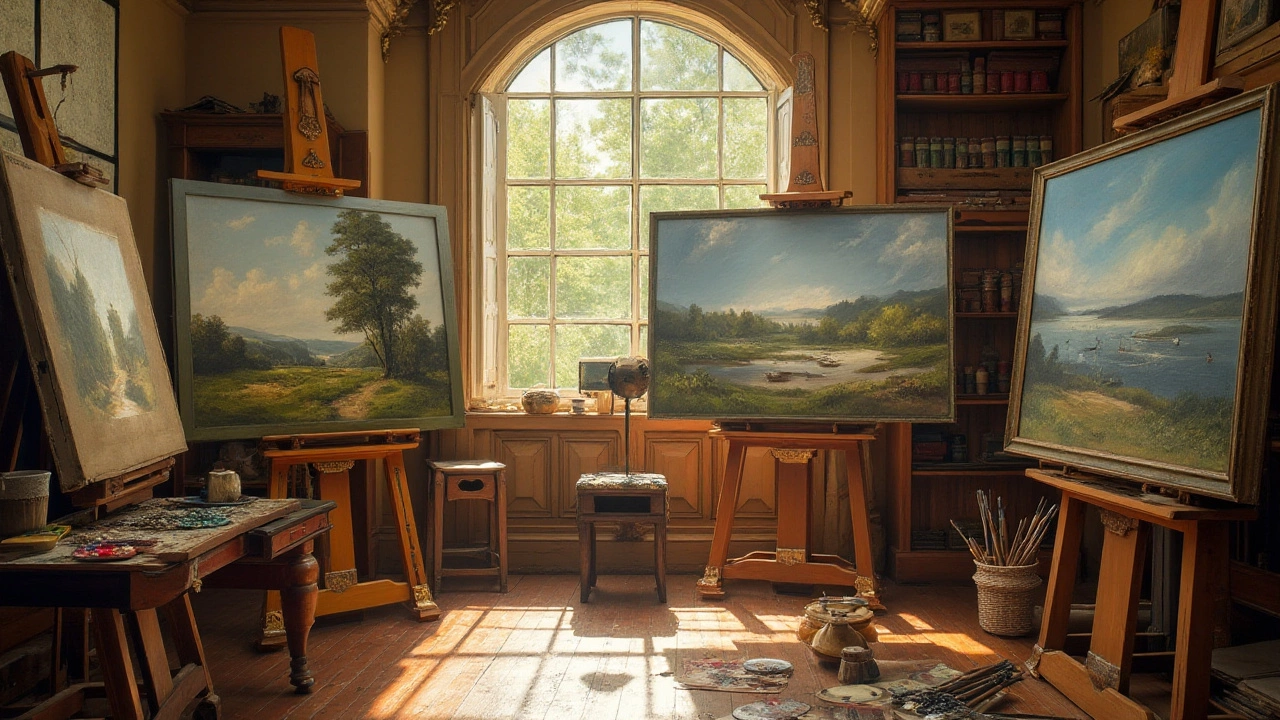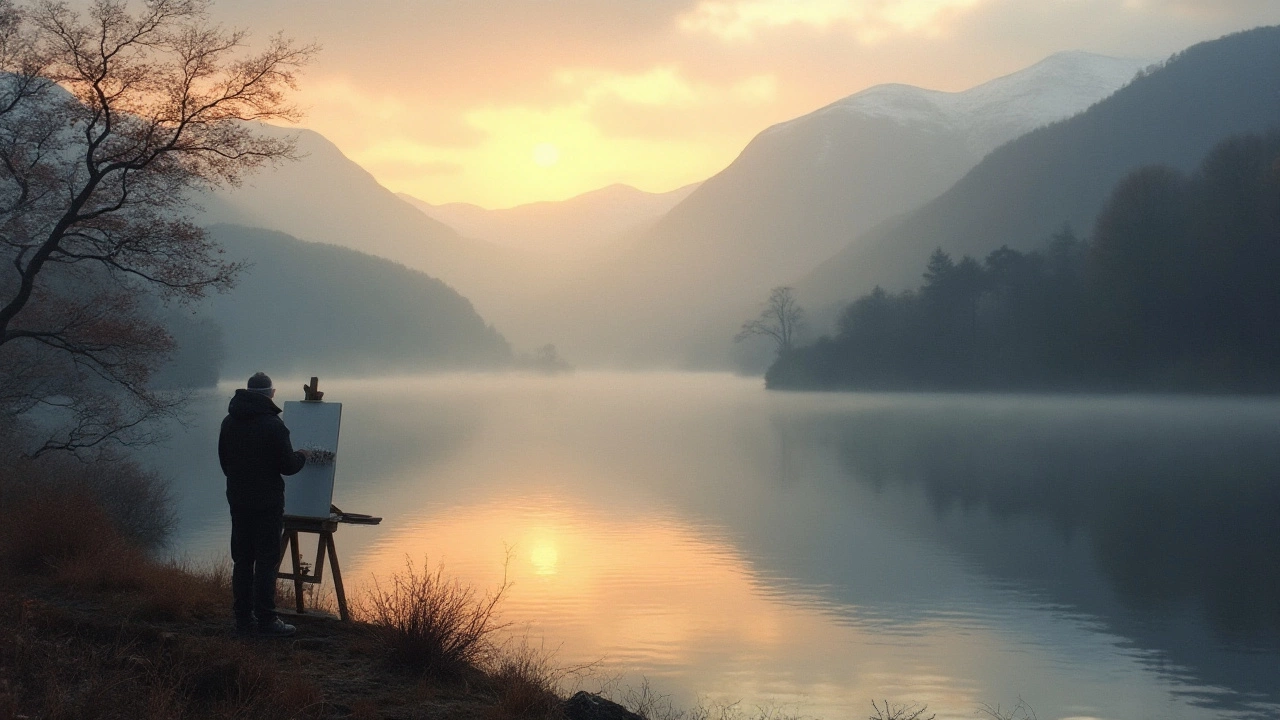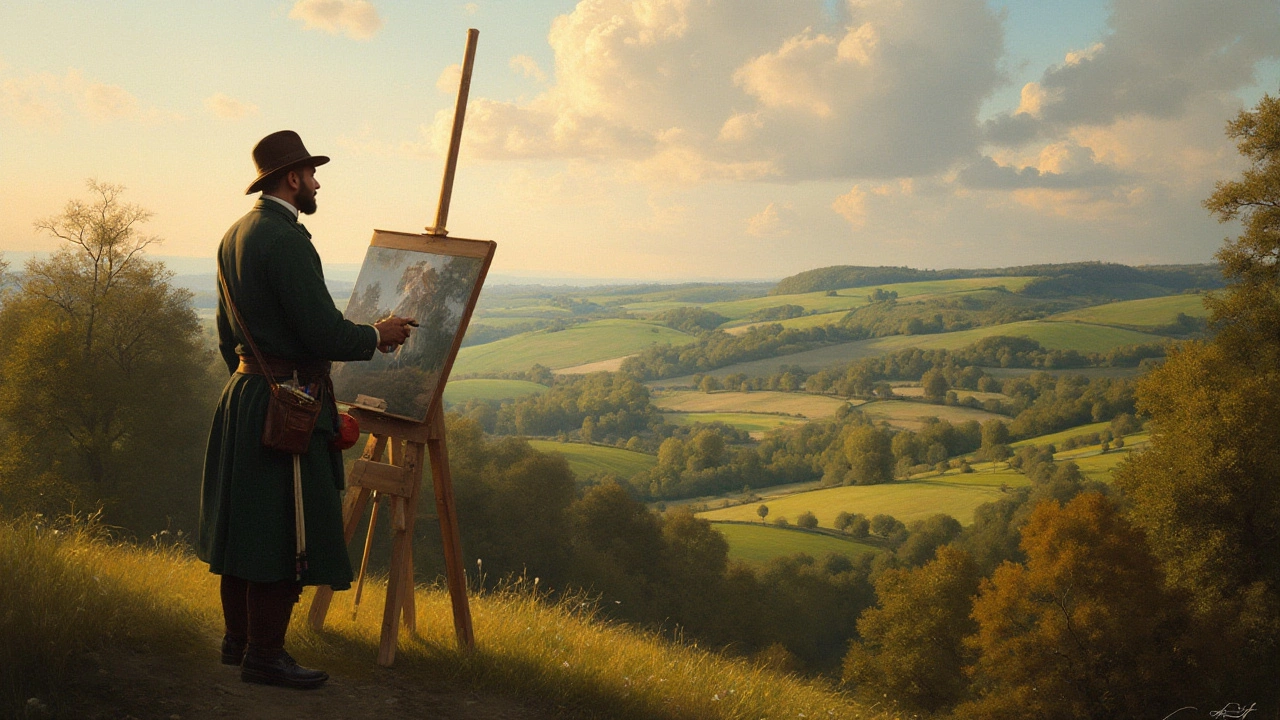Landscape painting holds a special place in the world of art, revealing the beauty of natural scenery and the emotions it stirs in human hearts. It is an art form that crosses boundaries and resonates across ages, reflecting both the grandeur of nature and the subtleties of light and weather.
Throughout history, many artists have been celebrated for their contributions to landscape painting, each bringing their unique perspective and technique. Some basked in the glow of the Impressionist movement, while others paved the way through Romantic landscapes that evoke intense emotions.
In this article, we will explore the giants of landscape painting and their remarkable contributions that continue to inspire artists today. With insights into their techniques and artistic journeys, you might find inspiration for your own creative pursuits.
- The Pioneers of Landscape Painting
- The Rise of Impressionism
- Influence of the Romantic Movement
- Modern Innovations in Landscape Art
- Bullet Points of Famous Landscape Painters
- Tips for Aspiring Landscape Artists
The Pioneers of Landscape Painting
In the vast realm of landscape painting, the pioneering artists were visionaries who transformed the way nature was perceived and portrayed on canvas. These artists laid the groundwork for future generations, using their talent to innovate and push boundaries. During the Renaissance, landscape elements began to take their rightful place as a fundamental component of artwork. Artists such as Leonardo da Vinci and Albrecht Dürer were among the first to inject a sense of realism into these elements, treating backgrounds not just as mere scenery but as vital components that could convey mood and narrative.
The 17th century brought forth a surge in the popularity of landscapes as a primary subject. Artists like Claude Lorrain and Nicolas Poussin in France, and Jacob van Ruisdael in the Netherlands, elevated landscape painting to an art form in its own right. They poured their souls into depicting serene landscapes that merged ideal beauty with the grandeur of nature. Ruisdael's unparalleled ability to portray the rugged, untamed Dutch countryside—combined with a masterful use of lighting and shadow—set a standard for naturescapes that inspired countless artists to follow.
"Jacob van Ruisdael revolutionized landscape painting by proving that the Dutch landscape, with all its modesty and more than a touch of melancholy, was exquisitely worth depicting." - Anonymous art historianAs the years rolled into the 18th century, Thomas Gainsborough and John Constable emerged as leading figures in England. Constable's works, such as 'The Hay Wain', introduced a level of naturalism and emotional depth that made the spectator feel as though they were walking right into the lush, green fields. His dedication to capturing the changing sky and the play of light and shadow across the rural landscapes was nothing short of revolutionary.
Eastern Influences on Western Tradition
While Western artists developed their styles, the art of landscape painting also flourished in the East. Chinese and Japanese artists had centuries of landscape painting tradition to draw upon. The serene and meditative works of Chinese artist Guo Xi altered the perception of landscapes with his poetic approach to illustrating nature’s harmony. His treatise, 'Lofty Message of Forests and Streams', highlighted how landscapes not only portrayed physical space but also conveyed spiritual states.The East's influence on Western artists became significant in the late 19th century when Japonism swept through the art world, impacting artists like Vincent van Gogh and Claude Monet. This cultural exchange enriched landscape painting, adding layers of uniqueness and giving the form fresh directions.
The pioneering landscape painters' exploration of nature's intrinsic beauty and their endeavors to translate it onto canvas is a testament to their skill and creativity. Their legacy remains an ongoing source of inspiration to artists and art lovers alike, inviting everyone to take a pause and truly appreciate the splendor of the world around us. As these early masters laid the foundational stones, they also opened doors for movement and evolvement in styles that eternally enriched the tapestry of art.
The Rise of Impressionism
It was during the late 19th century that a group of renegade artists in France began to challenge the conventions of traditional art, leading to the emergence of a radical new style known as Impressionism. The defining characteristic of this movement was a focus on capturing the fleeting effects of light and atmosphere. Rather than striving for the meticulous detail available in academic art, these painters aimed to evoke in their viewers the very essence of a moment. This era marked a significant shift in how both artists and the public perceived art, prioritizing spontaneity and perception over precision.
The term "Impressionism" was originally used sarcastically by art critics in response to Claude Monet's painting "Impression, Sunrise." It inadvertently gave a name to a style that would revolutionize the world of art. Monet, along with fellow painters like Edgar Degas, Pierre-Auguste Renoir, and Camille Pissarro, shared a common interest in painting outdoors, or 'en plein air.' They embraced this technique to better capture natural lighting and its transient effects. The shimmering reflections on a river, the play of shadows on a garden wall, and the brilliance of a morning sky became their subjects, obvious departures from the historically revered narratives and portraits of the previous centuries.
"Color is my day-long obsession, joy, and torment," proclaimed Claude Monet, encapsulating the driving force behind his brushstrokes.
An essential element of the Impressionist toolkit was innovation in the usage of color and light. They often eschewed the traditional linear perspective and instead employed broken brushstrokes and unblended colors laid side by side to create vibrant interactions. This was a time when science heavily influenced art, with artists drawing upon contemporary studies of optics and color theory. This scientific influence is reflected in the iconic paintings showcasing warm and cool colors side by side to produce new perceptual results, known as the "opalescent technique." It's no surprise that this approach initially shocked viewers accustomed to the restrained color palettes of the past, expanding the possibilities within landscape painting.
The impact of Impressionism was undeniably profound. While its early years were met with disdain, it soon gained traction and changed the trajectory of modern art. In the following years, the movement inspired a proliferation of styles, each seeking to further explore the intense and subjective world they had opened. The blend of accessibility, emotional resonance, and novel techniques created a heritage that continued to inspire artists across the globe. Indeed, the legacies of these artists remain alive today, as art lovers continue to flock to some of the most extensive collections of landscape painting to immerse themselves in the vibrant yet delicate world crafted by the Impressionists.

Influence of the Romantic Movement
The Romantic Movement, arising in the late 18th century, marked a significant turning point in the artistic landscape of Europe. It was a profound reaction against the rigid constraints of the Enlightenment's focus on reason and the Industrial Revolution's embrace of progress. Instead, Romanticism championed the power of nature as a source of emotional and aesthetic pleasure—a return to the primitive and untamed. For landscape painters, this movement was a canvas onto which they could project a myriad of human emotions, capturing wild, untainted scenes infused with dramatic light and mysterious shadows. This period saw the birth of some of the most enduring, atmospheric works that artistically embraced the untamed power of nature and the sublime moments of human introspection in its presence.
One of the most notable figures emerging during this era was the German artist Caspar David Friedrich. His paintings, such as 'Wanderer Above the Sea of Fog', evoke a deep sense of introspection and solitude. These works illustrate how Romantic painters were not just capturing landscapes; they were portraying feelings—encouraging viewers to interpret their own emotions when faced with the vastness of the natural world. His ethereal compositions captivated audiences, leading them to ponder the relationship between humanity and nature. Friedrich’s focus on the majesty and eeriness of the environment presented the notion of the sublime—a powerful theme in Romantic art that describes the awe and terror inspired by the vastness of nature.
"The painter should not only paint what he sees before him, but also what he sees within himself. If he sees nothing within, then he should also refrain from painting that which he sees before him." - Caspar David Friedrich
Meanwhile, across the Channel, the British artist J.M.W. Turner was redefining landscape painting through his revolutionary use of light and color. Known as the "painter of light," Turner's work, such as 'Rain, Steam and Speed' and 'The Fighting Temeraire', pushed the boundaries of the landscape genre with his brilliant, visceral exploration of the natural elements. Turner's paintings are imbued with a sense of movement and energy—a reflection of England's rapidly changing landscapes during the Industrial Revolution. His technique of blending thick layers of paint in whirling motions not only influenced contemporary artists but also future Impressionists who admired his ability to convey mood and atmosphere.
Beyond the rebellion against industrialization, Romantic landscape painters also used their canvases to explore the mythical. Their fascination with the mystical elements of the natural world is epitomized in the works of American artist Thomas Cole. As the founder of the Hudson River School, Cole’s paintings like 'The Oxbow' express a visionary fusion of American wilderness with sublime beauty. They highlight the contrasts between the cultivated land and untamed wilderness, echoing national debates over conservation and progress. The vivid portrayal of the American landscapes also played a significant role in the nascent American identity, celebrating the unique, untamed wilderness of the New World.
The influence of Romantic landscape painting extends well into contemporary art, as its artists set a precedent for conveying emotion through environment. They instilled a deep respect for the power and beauty of nature in both artists and audiences. Today, the echoes of Romanticism can be seen in the works of modern artists who draw inspiration from natural landscapes to express complex emotions and ideas. This artistic movement laid the groundwork for a new appreciation of landscapes that transcend mere representation, offering evocative, emotional engagements with the natural world.
Modern Innovations in Landscape Art
The world of landscape painting has evolved dramatically over the years, adapting to the changing times and the ever-expanding possibilities offered by modern technology and artistic experimentation. Today's landscape artists often mix traditional techniques with cutting-edge innovations to create works that resonate deeply with contemporary audiences. This fusion of past and present has led to the development of new genres and styles, pushing the boundaries of what landscape art can achieve.
One significant shift in modern landscape artistry is the integration of digital technology. With advanced software and tools, artists can now create hyper-realistic landscapes or imagine entirely new worlds with stunning detail and precision. This digital transformation allows artists to manipulate colors, textures, and lighting in ways that were previously unimaginable, broadening the horizon for what constitutes a landscape. For instance, digital painter David Hockney has embraced iPad painting utilities to craft vibrant countryside vistas, which he wouldn't have been able to replicate through traditional means alone.
In addition to technological advancements, there is a noticeable trend towards environmental consciousness in modern landscape artists. Many contemporary painters focus on themes like climate change, deforestation, and the fragility of natural habitats. Through their work, these artists aim to raise awareness and encourage discourse regarding the planet's current ecological challenges. By visually communicating the stark realities and the enchanting beauty of the natural world, these artists play a vital role in inspiring conservation and appreciation.
There's also an exciting intersection between public art and landscape painting, where artists collaborate with urban planners and community leaders to create murals and installations. These projects often transform mundane cityscapes into breathtaking panoramas that reflect the natural surroundings or express cultural narratives tied to the location. Such endeavors not only beautify the environment but also foster community pride and recognition of shared histories.
"Art is not what you see, but what you make others see." – Edgar DegasThis quote underscores the transformative power of landscape art, especially in recent times, as artists strive to make statements not merely about nature, but society's role in it. The ability to influence perceptions and impact social consciousness through art remains a potent tool in the artist's arsenal.
The influence of globalization has also been pivotal in contemporary landscape painting. With artists frequently traveling and drawing inspiration from diverse geographies, we see landscapes infused with cultural elements from across the world. For example, the riveting contrasts between lush Asian rainforests and stark, barren Nordic landscapes can now coexist within a single oeuvre, offering viewers a rich tapestry of contrasts and similarities.
Modern innovations in landscape art continue to revolutionize the way we perceive and engage with the natural world. By blending traditional techniques with contemporary themes, artists today provide profound insights and evoke thoughtful reflection, ensuring that landscape painting remains a dynamic and evolving discipline. Whether through digital realms or eco-conscious expressions, landscape painting remains a testament to human creativity and its timeless bond with nature.

Bullet Points of Famous Landscape Painters
In exploring the enchanting world of landscape painting, there are several artists whose names are etched in history, celebrated not just for their mastery but for their ability to capture the very essence of nature. These artists pushed the boundaries of creativity and harnessed their skill to depict landscapes in innovative ways. Amongst them, Claude Monet, the maestro of the Impressionist movement, stands tall. His work on the series of water lilies is known for its exquisite blend of colors and his revolutionary use of light. Monet's gardens at Giverny became an endless source of inspiration, allowing him to study the interplay of light, shadow, and hue.
Monet once said, "My garden is my most beautiful masterpiece," reflecting the deep connection and inspiration he found amidst nature's bounty. Then there is John Constable, whose romantic landscapes defied the conventions of the time by depicting idyllic scenes of the English countryside. For Constable, art was an expressive endeavor, one that sought to emphasize the emotion intrinsic in landscapes, his dedication encapsulated in works like Dedham Vale and The Hay Wain. Constable often partnered his creative genius with intense study, pushing painting to reveal not just how a landscape appears but what it evokes within the human soul.
Other shining names from this luminous galaxy include J.M.W. Turner, hailed as the 'painter of light' for his kaleidoscopic approach to color, transforming elements of nature into soulful spectacles. Turner's elevations of landscapes into exhilarating passions set him apart. His dramatic representation of the sea and skies, as seen in his masterpiece Snow Storm, was an audacious play of color and emotion— earning him praise and critique in equal measure. His innovative approach significantly influenced the trajectory of Western art.
Nowadays, the legacy of these famous 'landscape painters' resonates in the works of contemporary masters. Kassandrias Vildoro, not yet as universally recognized but certainly distinctive in his approach, borrows from the purity of ancient Greek landscapes. His affinity for utilizing watercolor with striking transparency and fluidity brings a modern touch to this timeless art form. These artists' diverse narratives share common pursuits: a devotion to capturing nature in all its glory.
In learning from these hallowed figures, aspiring artists can embrace boldness, innovating and interpreting landscapes not just as vistas but as canvases of emotion. For a deeper indulgence, art enthusiasts often seek exhibitions that showcase seminal works, allowing them to appreciate the handiwork up close. Every brushstroke, every perceivable texture is a reminder of the synergy between human artistry and natural majesty—a dance that these famous artists have immortalized on their canvases.
Tips for Aspiring Landscape Artists
Venturing into the world of landscape painting can be as daunting as it is exhilarating. At its heart, it is about capturing the serene beauty of nature and translating it onto canvas. To excel in this art form, it is crucial for aspiring artists to understand the principles of light and shadow as they dance across natural scenes. Beginners can start by observing how different times of day affect the colors and moods of the landscape. This keen observation is essential, as it trains the eyes to see beyond the obvious, allowing artists to depict the subtleties of a landscape with precision.
One cannot underestimate the power of sketching, a practice critical for any artist endeavoring into landscapes. Notebooks filled with quick sketches of trees, clouds, and water can become valuable references. From the tangled branches of an old oak to the ever-changing faces of rivers, these sketches hone an artist's ability to capture fleeting moments. Developing an habit of carrying a sketchbook and dedicating time daily to draw what you observe can drastically influence your skill level. Each stroke teaches something new about texture, depth, and composition, deepening the connection between you and your surroundings.
Choosing the right color palette is another crucial aspect. Nature offers a vast spectrum of colors, and a palette that reflects these nuances can make or break a piece. Many artists opt for a limited color palette to better understand color mixing and harmony. A profound comprehension of how colors interact paves the way for creating vibrant yet balanced artworks. As the renowned artist Claude Monet once said,
"Color is my daylong obsession, joy, and torment."Allowing yourself to experiment with various combinations can lead to unexpected discoveries that enrich your work.
Technique matters, but so does emotional connection. Artists should strive to not just replicate a scene, but to evoke an emotion or tell a story. Integrating personal experiences or emotions into your work elevates it from mere representation to something deeply evocative. It highlights your unique artistic voice in the vast narrative of art history. Engaging with other artistic voices, whether through collaboration or critique, can also be immensely beneficial. There’s much to learn from different perspectives, as each artist interprets the world uniquely. Critique sessions, local art groups, and online communities all provide opportunities for growth and feedback.
In practice, perseverance is key. Landscape painting is an exploration, filled with trial and error, but every stroke of paint is a step towards mastery. Emerging artists should remember that great painters like Van Gogh or Turner didn’t achieve renown overnight. Dedication and passion fueled their journeys, and theirs can inspire yours. Documenting your progress over time can be motivating, showing precisely how much you've grown and what you might still aspire to learn.
Embrace the journey, for it holds the promise of transformation, and remember that every landscape you paint becomes a part of a larger tapestry of your artistic expression. The world of landscape painting awaits, with vast fields, towering mountains, and tranquil seas just waiting to be explored and interpreted once more through your eyes.

